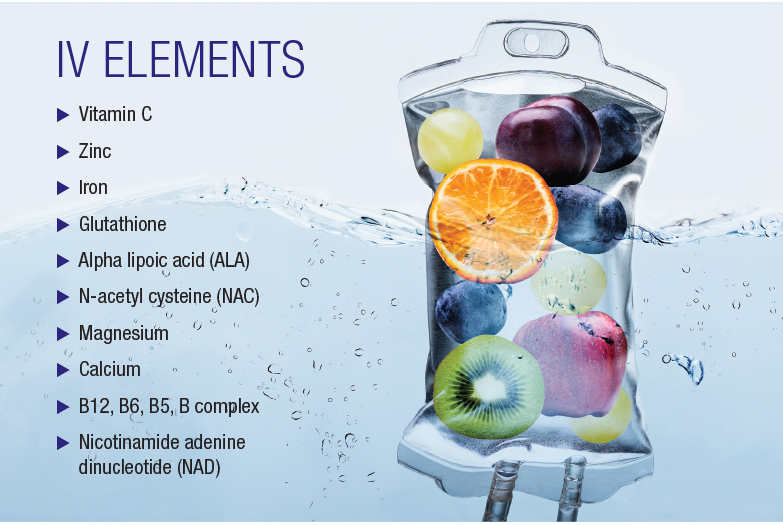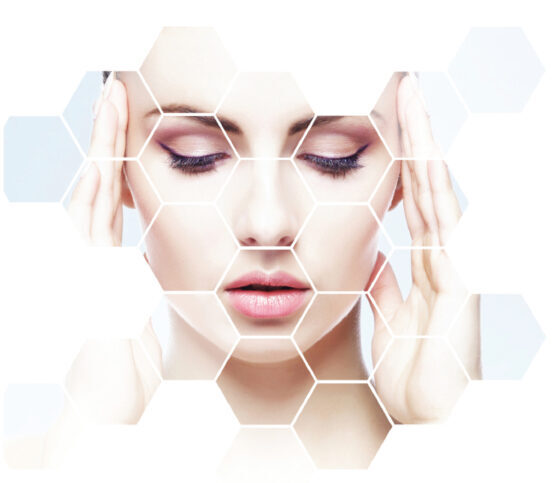Deepa Verma, MD, with Eliza Cabana

Integrative medicine specialist Deepa Verma, MD, demystifies IV therapy and offers practical advice for adding it as an aesthetic treatment to the dermatology practice.
“We always think of beauty as things we do on the outside. But what we have to understand is it starts from within. I always address gut health. Doing IV therapy is a great way to give the skin a nice glow and to boost collagen and the growth of new cells,” said Deepa Verma, MD, founder of Synergistiq Integrative Health, Clearwater, Florida.
Dr. Verma is board-certified in family and integrative medicine and has been using IV therapy in practice for 7 years. She presented “How to Increase Longevity with IV, Gut Health and Diet,” at A4M (American Academy of Anti-Aging Medicine) Dubai UAE, June 4-5, 2020.
More than mere aesthetics, IV therapy is used to address many health issues, from energy levels and immunity to cancer, skin conditions, and autoimmune disease, she said.
Helping skin from within
Probably the most well-known is the Myers’ Cocktail, a mix of IV vitamins and minerals initiated by John Myers, MD, in 1960s. The IV-infused cocktail includes magnesium , calcium, B12, B6, B5, B complex, and vitamin C. IV infusion allows for a higher concentration of nutrients to directly enter and circulate throughout the body.
“Let’s just think about it,” said Dr. Deepa. “IV therapy is intravenous therapy. So we’re bypassing the gut. This is the key. This is 100% efficacy in terms of the availability of what you’re administering. Whereas if you do something orally, you’re lucky if you get even 35% to 50% because it has to go through your gut and everybody has gut issues.
“I use IV Myers’ for a lot of different things: migraines, alcohol hangovers, fibromyalgia, low energy, infections, colds, and more. So people recover more quickly than with oral treatment.
They get a lot of energy. They feel good right away is because it’s going right into the veins, and it’s circulating throughout the body. To put it in perspective, if someone’s feeling sick and takes extra vitamin C orally, anything higher than 1 g to 3 g will affect the gut, leading to diarrhea. With IV therapy, we’re giving anywhere from 10 to 50 times the amount that we can take orally. Bioavailability is large enough to get used properly and you’re going to feel the effects right away: energy, clarity. Your immunity is going to be boosted. That’s why IV therapy is so great.”
Ingredients for aesthetic IV therapy
It’s well known that inflammation is the root cause of many skin and dermatologic conditions.
“We often label things as dermatitis. We have hyperpigmentation disorders. We have skin issues that are associated with certain disease processes—melasma, lupus, or an autoimmune condition, and general aging issues: crepiness of the skin, the fine lines, the wrinkles, the loss of collagen,” said Dr. Verma. “When I concoct these IVs, I’m looking at the building blocks that we need to regain youthfulness and get elasticity back in the skin.”
Her most-used ingredients include vitamin C, glutathione, and alpha lipoic acid (ALA).
“I always start with vitamin C. Vitamin C is really my go-to for everything. Ascorbic acid is very essential in boosting immunity and also helps with your skin in terms of collagen. Zinc is also something that’s very, very important for the foundation of your skin,” she said. “So ascorbic acid is always the base. Glutathione is another one. Glutathione is a master antioxidant, and its precursor is NAC, N-acetyl cysteine.”
NAC, often associated with liver detox, is used to treat acetaminophen poisoning. But it also replenishes glutathione. “As we age that declines,” said Dr. Verma. “Also associated with aging are a decline in immunity, more propensity for chronic conditions, signs of aging skin—it starts getting dull, crepey, thin. We can start seeing vessels depending on your skin type.”

In many ethnic cultures, glutathione is often used also for “lightening” the complexion. It won’t actually make the skin lighter, but it can help to create a more even complexion and make skin glow.
ALA helps to reduce inflammation. “So if someone is suffering from rosacea or eczema or psoriasis, I like to use ALA,” said Dr. Verma. “I also use amino acids. As we know those are the building blocks—the protein building blocks. And that’s very important as well in the foundation of skin integrity.”
IV therapy treatment protocols
“There are no cookie-cutter protocols. Everyone’s going to be different. I really have to assess them: look at where they are in their life, what medical conditions they may have, and what their lifestyle is,” said Dr. Verma.
For aesthetic treatment, if someone is looking for fresher skin with a nice glow, Dr. Verma may recommend laser and/or RF microneedling treatment followed by IV therapy to help with healing.
In general, the protocol would be a 1-2 IV sessions per week of 10 g to 15 g vitamin C plus 2 g to 4 g glutathione for at least 6 weeks. “I customize it. It depends on their availability, but that’s the typical protocol that I like to use,” she said.
In terms of chair time, the more common IV therapies, including Myers’ cocktail, vitamin C, iron, and ALA, generally take from 45 to 60 minutes.
IV therapies with NAD (nicotinamide adenine dinucleotide), used for anti-aging, addiction, and depression, can take up to 90 minutes. Those for chelation or heart health can take 2 to 3 hours.
REFERENCES FOR FURTHER READING
Gaby AR. Intravenous nutrient therapy: the “Myers’ cocktail”. Altern Med Rev. 2002 Oct;7(5):389-403. PMID: 12410623.
Ogston-Tuck S. Intravenous therapy: guidance on devices, management and care. Br J Community Nurs. 2012 Oct;17(10):474, 476-9, 482-4. doi: 10.12968/bjcn.2012.17.10.474. PMID: 23124374.
Padayatty SJ, Sun H, Wang Y, Riordan HD, Hewitt SM, Katz A, Wesley RA, Levine M. Vitamin C pharmacokinetics: implications for oral and intravenous use. Ann Intern Med. 2004 Apr 6;140(7):533-7. doi: 10.7326/0003-4819-140-7-200404060-00010. PMID: 15068981.
Jamali M, Majid A. Intravenous glutathione for fair skin; to give or not to give? J Pak Med Assoc. 2017 Jul;67(7):1127. PMID: 28770905.
DISCLOSURES
Dr. Verma reports no relevant financial interests.


